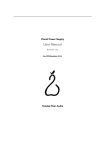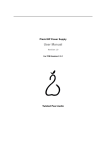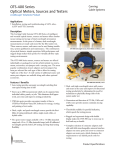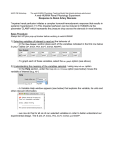Download Manual - Twisted Pear Audio
Transcript
Placid HD BP Power Supply User Manual Revision 1.0 For circuit board v1.0 and “Black Label” (see addendum) Twisted Pear Audio Overview The Placid HD BP is a shunt regulated bipolar DC power supply designed for low noise and excellent line and load regulation. It is primarily intended for ±10-20VDC supplies using transformers with 12-20VAC secondaries. NOTE: It is very important your read the manual prior to trying to use this power supply. Make sure you understand how to adjust the output voltage and CCS current before you do anything else. You could easily destroy something if you do not know what you are doing. This supply has a slight negative temperature coefficient, meaning that as it gets hotter as the output voltage gets lower. This is generally a good thing, but it requires that you remember that the regulated voltage will always be higher at startup then when than unit is warm. Always ensure that the output voltage will not go above what the supplied device can handle. This is not a difficult circuit to use, but it is also not trivial so be careful. You can learn a lot from the schematic, so take advantage of it. There is no shame in asking questions. Please ask them before you do anything you might regret later. ☺ Default Configuration The supply is designed to be fed by a dual secondary transformer. For the purposes of this manual we will assume you are aiming for 12VDC output and ~350mA per rail max load current. This is just an example so please be sure you are adjusting for your actual target application. The kit included parts are suitable for this setup. If you need significantly higher current or voltage drop you may need to change some parts. We will also assume you have a transformer with a 12-15VAC secondary rated at 15VA or more. First Steps/Assembly The most flexible way to setup the supply is by using the provided variable resistors (potentiometers) for VR1 and VR2 (supplied in kits). For a more robust long-term configuration, VR1 and VR2 can be replaced with fixed value resistors using the VR1 and VR2 positions. Either choice is just fine. Populate the circuit board as you normally would; mount components from shortest to tallest. Each part in the kit it labeled with a part number that matches the part numbers on the circuit board. Because the two sides of the supply are virtual mirror images, each part (except for transistors) are labeled with A and B (e.g. “R1A” and “R1B”). The matching parts in the kit are labeled with the base part number (e.g. R1), and there are two of each. It is best to mount the TO-220 transistors to the heat sinks prior to soldering them. Apply a very thin layer of thermal paste (included in kit) on the back of the transistor before mounting it. If you are supplying your own heat sinks, make sure they are suitable for you application. The included heat sinks will work well up to around 350mA with 15VAC input and 12-15VDC output voltage. For other applications you may want to use larger heat-sinks. Notice there are test points at various places on the PCB. Refer to the schematic for details. • To measure CCS current measure the voltage between TP-VIN and TP-CCS. The measure voltage is the same as the current sourced, example 250mV means 250mA is being sourced. • To measure the current being shunted measure the voltage between TP-OUT and TP-SHUNT. Keep in mind that for Placid HD BP there are two VR1 and two VR2 (A and B), one for each rail. Measure the resistance between the two outer pins of the trimmer. NOTE: VR1 adjusts the shunt current. VR2 adjusts the output voltage. 1. Adjust VR1 so that the resistance across it is 400R - 500R. This is a safe starting point. 2. Adjust VR2 so that it is around ~1K. 3. Connect the transformer to the supply with one secondary going to each rail. Do not connect a load yet. 4. Now apply power and adjust the output voltage (VR2) as needed for your application. 5. Now adjust the CCS current (VR1) as needed for your application. 6. Connect the supply to the load and re-check CCS and shunt current as well as voltage output. Dropping output voltage under load typically indicates that not enough current is being supplied to the load. Some Helpful Setup Tips The voltage reference (VREF) used to regulate the supply normally is ~3.85V. A little variation is normal because of variances in the LEDs. This is why you must measure the actual voltage at the output before you proceed to the use the supply. The more gain you use, the more the VREF variation will be apparent. The LED VREF will vary a small amount with temperature because of the LEDs negative temperature coefficient. For this reason we recommend adjusting the output voltage to just under my desired maximum voltage for the application. Something like 5% should be safe. The VREF will tend to decrease voltage a bit as it warms so it will start slightly high and then settle down little as it warms to a steady state. For example, if you know you want an absolute maximum VOUT of 15VDC, set the supply output voltage to around 14.75VDC when warm to allow for the slightly higher value at start-up. In most circuits the little bit of extra start-up voltage will not be an issue, but if it is in your case, you now know how to manage it. The formula for the output voltage is this: VOUT = VREF * (1+(RF/RG)), where RF is R12 and RG is R7. Based on that, here are some possible configurations using a fixed resistor to set VOUT. These assume the feedback resistor value is 1K. When using a fixed resistor for output voltage you would omit VR2 and use the two outer pads provided for the fixed resistor. You may need to try a few values to get the voltage you want. You can use VR2 temporarily to find that value, and then remove and replace it with a fixed value resistor, using the extra outer pads provided on the board. RG Approximate VOUT Open ~ 3.85V 2K ~7.8V 1K ~11.5V 750Ω ~14.5V If you require more than 15V you will probably want to increase RF. See the formula given earlier. A Few Advanced Tips Advanced users who want to do something other than the default configuration should understand the provided schematic. If you don't understand something then please ask for help before you go forward. If you do understand the circuit well enough to be confident in changing things around a bit, then here are some tips… If you need to supply > 500mA you will want to make sure you use adequate heat sinks. If the transformer is correctly sized this will not be too hard. You can also substitute fixed a resistor for the CCS potentiometer. Just do the calculations before-hand or measure the resistance across the potentiometer with it in place temporarily and after your happy with the current you can remove the potentiometer and substitute a .25W metal film fixed resistor at R1. Addendum: Some early kits have first run PCBs which have the version number marked out in black, so called “Black Label” boards. Those boards are electrically identical to the v1.0 boards, but have different silk screen reference descriptors. If the version number is not blacked out then the silk screen matched the v1.0 schematic. This manual is written using the v1.0 schematic. Both schematics have been included in this manual to make cross referencing easy. The PCBs are identical in every other way. This manual directly references this schematic. “Black Label” Circuit boards (with the version number blacked out) are marked according to this schematic. This schematic is for cross-reference only and is electrically identical to the v1.0 circuit boards. This manual references v1.0 part numbers.









